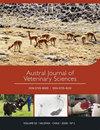Identification of potentially harmful bacterial genera of veterinary relevance in the Llanquihue urban wetlands
IF 0.8
4区 农林科学
Q3 VETERINARY SCIENCES
引用次数: 0
Abstract
Water bodies constitute natural, social, and ecological heritage under constant threat from the footprint of human action. They are the habitats of many species and play a key role in sustaining biodiversity in different ecosystems. However, anthropogenic activity can result in eutrophication of water bodies, favoring the excessive growth of microorganisms, which can be a risk factor for animal, human, and environmental health. The Agricultural and Livestock Service [Servicio Agrícola y Ganadero, (SAG)] of Chile developed a list of Mandatory Reportable Diseases (MRD) to report suspected contagious diseases of veterinary relevance. In this sense, the detection of microorganisms in water bodies for the characterization of their sanitary status is important for the development of monitoring strategies and the prevention of possible diseases. This study aimed to determine the presence of potentially harmful bacteria in Llanquihue urban wetlands. Here, we used metagenomic sequencing of amplicons to characterize the composition of microorganisms in three urban wetlands in the city of Llanquihue, which could be a risk factor for animal health. Our main finding was the detection of genera that may be associated with MRD, in addition to other microbial genera that have pathogenic potential. On the other hand, we also report the presence of cyanobacteria genera that can be involved in toxin production in water bodies as another potential source of risk. This is the first study to use massive sequencing techniques to analyze the sanitary status of urban wetlands in the city of Llanquihue.鉴定兰基韦城市湿地中与兽医有关的潜在有害细菌属
水体是自然、社会和生态遗产,不断受到人类活动足迹的威胁。水体是许多物种的栖息地,在维持不同生态系统的生物多样性方面发挥着关键作用。然而,人类活动会导致水体富营养化,有利于微生物的过度生长,从而成为动物、人类和环境健康的危险因素。智利农业和畜牧业服务局(Servicio Agrícola y Ganadero,SAG)制定了一份强制报告疾病(MRD)清单,用于报告兽医相关的疑似传染病。从这个意义上说,检测水体中的微生物以确定其卫生状况,对于制定监测战略和预防可能发生的疾病非常重要。本研究旨在确定兰基韦城市湿地中是否存在潜在的有害细菌。在这里,我们使用元基因组测序扩增子来描述兰基胡埃市三个城市湿地中微生物组成的特征,这些微生物可能是动物健康的风险因素。我们的主要发现是发现了可能与 MRD 有关的菌属,以及其他具有致病潜力的微生物菌属。另一方面,我们还发现水体中存在可能参与毒素产生的蓝藻属,这也是另一个潜在的风险来源。这是首次使用大规模测序技术分析兰基韦市城市湿地卫生状况的研究。
本文章由计算机程序翻译,如有差异,请以英文原文为准。
求助全文
约1分钟内获得全文
求助全文
来源期刊

Austral Journal of Veterinary Sciences
Veterinary-General Veterinary
CiteScore
1.60
自引率
0.00%
发文量
18
期刊介绍:
Austral Journal of Veterinary Sciences (formerly Archivos de Medicina Veterinaria) publishes original scientific contributions in English, containing the latest developments and discoveries in veterinary sciences. The journal covers topics such as animal health and production, preventive medicine, zoonosis, pharmacology and therapeutics, methods of diagnosis, and other areas related to the veterinary field.
Austral Journal of Veterinary Sciences aims to divulge information about advances in veterinary medicine among universities, research centres, industries, government agencies, biologists, agronomists and veterinarians.
 求助内容:
求助内容: 应助结果提醒方式:
应助结果提醒方式:


